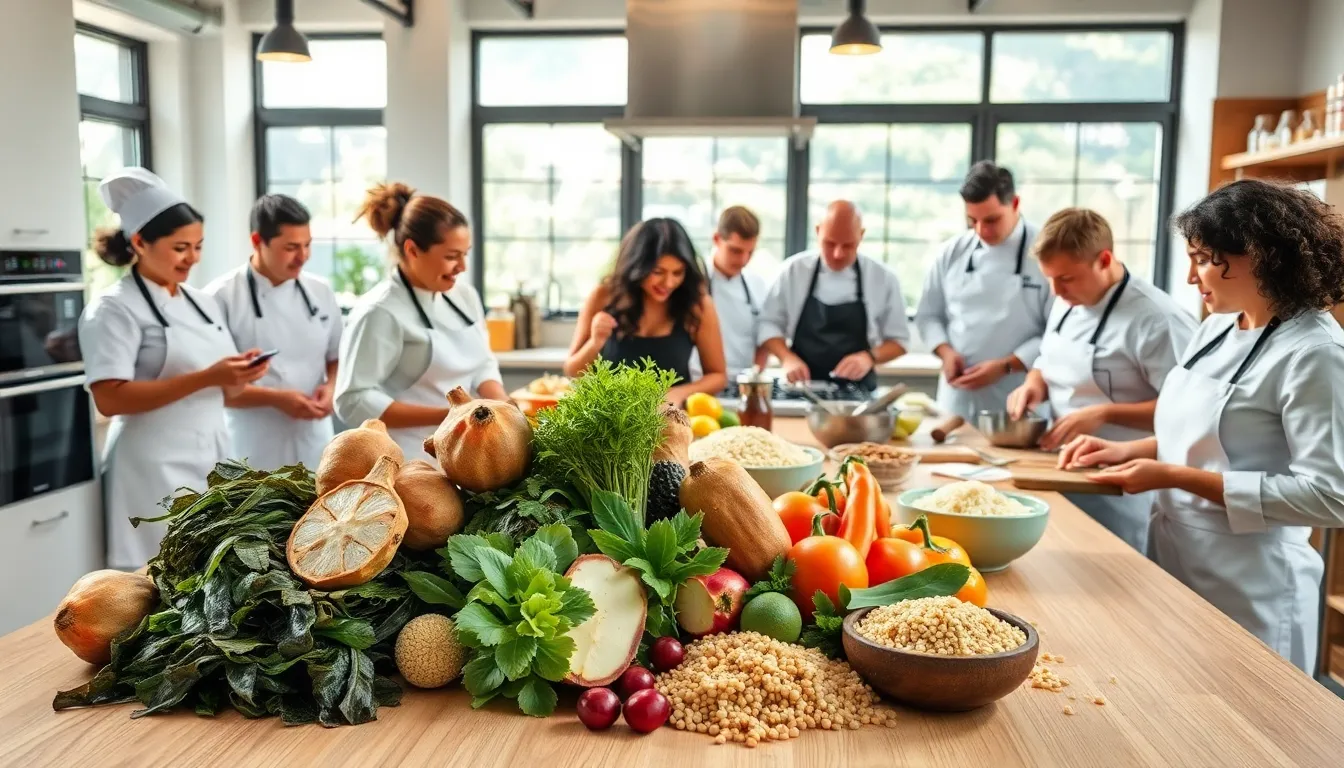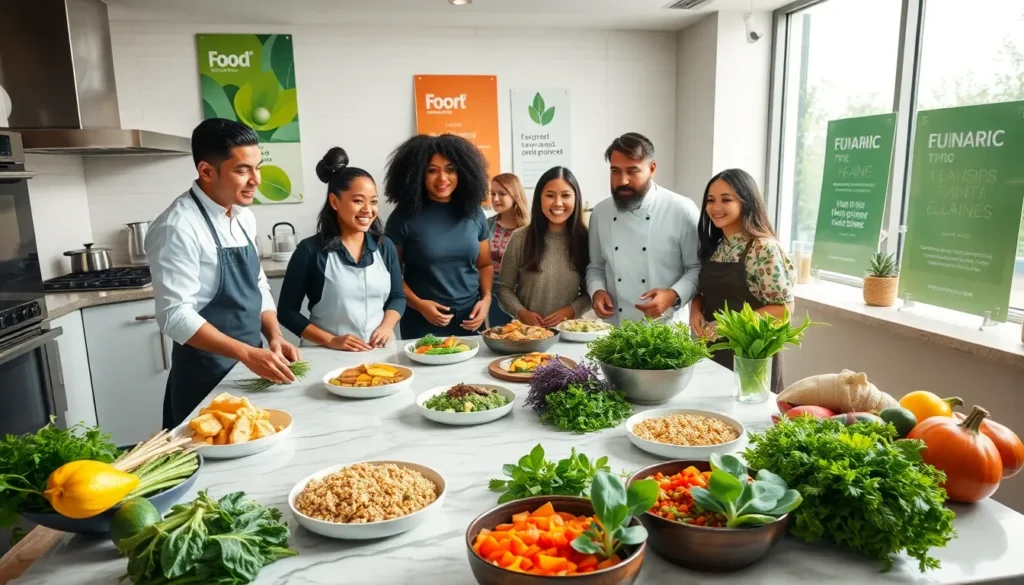When it comes to food, trends can shift faster than a chef can flip a pancake. Just when you think you’ve mastered avocado toast, a new ingredient swoops in, and suddenly it’s all about mushrooms. In 2025, food is not just about taste: it’s an exciting blend of health, sustainability, and global flavors. So, buckle up your taste buds because these trends are set to spice up not only your palate but also your dining experiences.
Table of Contents
ToggleEmerging Ingredients Shaping Modern Cuisine

In today’s culinary landscape, ingredients are stepping onto the scene with flair. Think about it: culinary innovation is bubbling over with exciting elements like seaweed, jackfruit, and even exotic grains like farro and quinoa, which have become staples in many kitchens. Their versatility allows chefs to craft dishes that not only taste amazing but also tell a story. Seaweed isn’t just for sushi anymore: it’s adding umami-rich flavors to salads, dressings, and snacks. Jackfruit, once a humble tropical fruit, can now be found as a meat substitute in tacos and sandwiches, proving that nature holds a treasure trove of options. Also, the push for healthier eating habits has people exploring ancient grains, each bringing unique textures and nutritional benefits to the table.
Other emerging ingredients include adaptogens like ashwagandha and medicinal mushrooms, which are being incorporated into smoothies, teas, and even desserts. These ingredients are not just food: they’re a pathway to overall wellness. As culinary professionals and home cooks alike embrace these trends, it’s clear that the ingredients making waves in 2025 are not just enhancing flavor, but they’re also transforming our health one bite at a time.
Sustainable and Organic Eating Habits
Sustainable eating is no longer just a trend: it has evolved into a lifestyle choice for many. Today’s consumers are more conscious about where their food comes from and how it impacts the planet. A significant rise in organic produce signifies this shift. Organic farming practices not only avoid harmful pesticides but also promote biodiversity, quality, and the health of our soil. To many, these conscious choices extend beyond fruits and vegetables: they encompass dairy, meats, and processed foods as well. People are opting for brands that align with their values, avoiding those that compromise on sustainability.
Also, zero-waste cooking is gaining traction. Individuals are creatively repurposing vegetable scraps, and fruit peels to eliminate waste in their kitchens. Recipes for vegetable broth made from leftover vegetable trimmings have flooded social media, proving that nothing is too far gone to be transformed into something delicious. As more restaurants embrace sustainability, it is clear that the future of dining is intertwined with a commitment to preserving our environment.
The Rise of Plant-Based Diets
Gone are the days when a plant-based diet was viewed as an extreme lifestyle. In 2025, it’s becoming a delightful norm, embraced by a diverse array of eaters, from vegans to omnivores looking to reduce their meat consumption. The curiosity surrounding plant-based eating has evolved from mere novelty to a culinary adventure. The speed at which new plant-based products are launched is nothing short of impressive. Brands are churning out everything from plant-based cheese and milk to meat-like options that mimic their animal counterparts.
This shift isn’t purely about health either: it ties into concerns about animal welfare and environmental sustainability, resonating deeply with younger generations. People are discovering just how satisfying and flavorful plant-based dishes can be, not to mention all the creative ways to incorporate vegetables into their meals. Food tech is also playing a crucial role by enhancing flavor profiles and textures, making the transition smoother for those curious about this green journey. The result? Comfort foods like burgers and pizzas now come packed with plant-powered goodness.
Global Flavors and Influences
As the world becomes more connected, global flavors are finding their way into local kitchens, making dining experiences truly multicultural. The popularity of international cuisines has skyrocketed, with diners eager to explore authentic flavors from distant lands. Dishes from places like Morocco, India, and Thailand are not just confined to traditional restaurants: they’re being incorporated into everyday meals, from street food stalls to high-end dining establishments.
Fusion cuisine is also on the rise, offering inventive combinations that spark creativity and excitement. Picture this: a kimchi taco or Italian curry pasta. The willingness to experiment with global influences means that chefs and home cooks are constantly innovating, turning kitchens into melting pots of flavor. As people share their explorations on social media, it’s clear that the appetite for international fare is insatiable.
Health-Conscious Choices
Today’s diners are not just looking for tasty meals anymore: they seek health-conscious options that make them feel good about their choices. Nutritional awareness has surged, with individuals gravitating toward meals packed with superfoods, dark leafy greens, proteins, and healthy fats to optimize their health. Restaurants are now showcasing calorie counts and nutritional information directly on their menus to cater to this demand.
Also, personalized nutrition is emerging as a trend, where diners are not just eating for enjoyment but also considering personal health metrics. Options tailored to specific diets, like keto, paleo, or gluten-free, have become mainstream. The drive for nutrient-dense meals has spawned a revolution in culinary thinking, pushing chefs to be transparent about their ingredients and cooking methods as they cater to a savvy clientele that cares about what goes into their bodies.
Technological Innovations in Food Production
Technology is making a significant impact on how food is produced, and it’s changing the game for both sustainability and efficiency. Methods like vertical farming, hydroponics, and aquaponics are now viable alternatives, allowing for food production in urban areas, reducing transportation costs. This tech-based approach isn’t only helping to eliminate food deserts, it’s also providing fresh, locally-sourced produce year-round.
Besides, advancements in biotechnology are leading to genetically modified organisms (GMOs) that promise higher yields while requiring fewer resources. Innovations such as lab-grown meat are gaining traction, as they present a sustainable alternative to traditional animal farming. With the continued commitment to technological advancements, the future of food production looks bright, offering endless possibilities for sustainable practices that benefit both consumers and the environment.
Culinary Experiences and Social Eating
Food has always been a social experience, but in 2025, it’s become a core aspect of social interactions. The rise of culinary experiences, think cooking classes, food tours, and immersive dining, is shaping how people connect over meals. Diners are keen to learn about the ingredients, techniques, and cultures behind their meals, making dining a more engaging experience.
Pop-up dining events and food trucks have also fueled a social atmosphere, drawing food enthusiasts seeking novel experiences rather than just conventional meals. Social media has amplified this trend, allowing diners to share their culinary adventures and recommendations with friends and followers alike. As a result, restaurants are no longer just places to eat: they’re evolving into hotspots for connection, learning, and adventure. People are seeking memories and stories associated with their meals, not just sustenance.

